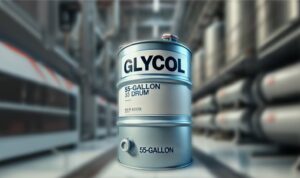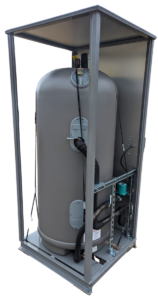We have assisted hundreds of breweries with chiller sizing and selection and often get asked how to calculate heat load for new and growing craft breweries. So we decided to make a guide with examples. It starts with a quick summary, then provides a detailed step-by-step brewery chiller sizing guide with examples. We finished with cautionary tips that every start-up needs to know.
To size a brewery chiller:
- Calculate the primary heat load:
fermentation tanks load (total bbl.’s x 4200 / 70 hours) - Calculate the pull down load:
(bbls x 271 x 40F/ 24 hours) - Calculate the brite tanks (holding) load:
(bbl.’s x 31 gallons x 8.33 lbs. x 40F delta T / 48 hours) - Calculate the secondary load on the second stage of the wort heat exchanger (if applicable):
(bbl.’s of kettle x 31 gallons x 10F delta T / 1 hour) - Size the brewery glycol chiller based on the higher of the primary or secondary load
- Add a 15% safety factor to compensate for heat loss in pipes, pumps, etc.
Read on for a comprehensive, step by step guide, with examples for sizing a brewery chiller. Read every word or just follow the examples. If you need help, our sales engineers will be happy to assist you.
Have an Operating Plan
If you are a start-up brewery, it will be helpful when working through the examples to think about how you will be operating your brewery. If you are an existing brewery, this will be easier for you. Think about your current operation and the future and answer the following questions before proceeding. How often do you brew? How much time is there between brews. Are you growing at a steady pace?
I. Calculate The Pull Down Loads (crashing the fermenters)
Pull down occurs when you are dropping the temperature (i.e. pulling down the temperature) of your fermenters and (other than wort cooling) is the largest cooling load. You will need to know the size of your tanks, temperature drop and time you have to achieve the desired temperature.
1. Calculate the total volume in gallons for fermenters pulling down simultaneously
A. 1 bbl = 31 gallons so a 7 bbl tank = 217 gallons
Example: Let’s assume we have three, 7 bbl tanks.
217 x 3 = 651 gallons
2. Multiply the total gallons by 8.33 to get total pounds
Example: 651 gallons x 8.33 = 5,422.83 pounds
3. Multiply the total pounds by your temperature difference
A. Commonly that is 75F degrees minus 34F degrees or 41F degrees
Example: 5,422.83 pounds x 41 = 222,336.03 total Btu
4. Divide by the hours of your pull down (crash).
Example: 222,336 / 24 hours = 9,347.33 Btu/hr.
If your pull down time is 12 hours, you would need 18,528 Btu/hr.
222,336 / 12 = 18,528 Btu/hr.
This is the Btu/hr. required for your pull down process. Many brewers will
add 10% or 15% to this number to compensate for extra heat being added
by the pumps, heat loss and inefficiencies of their systems.
II. Calculate Heat Load for Active Fermentation Tanks
1. Multiply the total bbls by 15 bricks.
Example: 21 bbls x 15 = 315
2. Multiply by 280 Btu / brick
Example: 315 bricks x 280 Btu = 88,200 Btu
3. Divide by 70 hours
A. 70 hours is the typical time frame that most of the heat gain from the yeast occurs, even if/when the fermentation period is more than 75 hours.
Example: 88,200 / 70 = 1,260 Btu/hr.
III. Calculate the Heat Load for any Jacketed Brite or Conditioning Tanks (not in your cooler)
Example: this will be similar to the pull down load calculation, except we use 48 hours instead of 24 hours and a temperature drop of 35F instead of 41F degrees.
IV. Total the Primary Tank Load
Total up thePull Down Load, the Active Fermentation Load and the Brite Tank Load (if any) Together for the Total Primary Btu/hr. Load
Example: 18,258 Btu/hr. plus 1,260 Btu/hr. = 19,518 Btu/hr.
V. Cold Liquor Tank (CLT)
1. Calculate the total volume in gallons of CLT
A. 1 bbl = 31 gallons so a 7 bbl tank = 217 gallons
Example: Let’s assume we have three, 7 bbl tanks.
217 x 3 = 651 gallons
2. Multiply the total gallons by 8.33 to get total pounds
Example: 651 gallons x 8.33 = 5,422.83 pounds
3. Multiply the total pounds by your temperature difference of your water source minus target CLT temp.
A. 75F degrees minus 34F degrees or 41F degrees
Example: 5,422.83 pounds x 41 = 222,336.03 total Btu
4. Divide by the hours of your recovery time (time between batches)
Example: 222,336 / 24 hours = 9,347.33 Btu/hr.
If your recovery time is 12 hours, you would need 18,528 Btu/hr.
222,336 / 12 = 18,528 Btu/hr.
This is the Btu/hr. required for your CLT. Many brewers will
add 10% or 15% to this number to compensate for extra heat being added
by the pumps, heat loss and inefficiencies of their systems.
VI. Wort Cooling
1. Calculate the total volume in gallons of your brewhouse
A. 1 bbl = 31 gallons so a 7 bbl brewhouse = 217 gallons
Example: Let’s assume we have three, 7 bbl tanks.
217 x 3 = 651 gallons
2. Multiply the total gallons by 8.33 to get total pounds
Example: 651 gallons x 8.33 = 5,422.83 pounds
3. Multiply the total pounds by your temperature drop
A. 85F minus 75F = 10F
Example: 5,422.83 pounds x 10 = 54,228.30 total Btu
4. Divide by the hours of your recovery time (time between batches)
Example: 54,228 / 1 hour = 54,228 Btu/hr.
If your recovery time is 30 min., you would need 108,456 Btu/hr.
54,228 x 2 = 108,456 Btu/hr.
This is the Btu/hr. required for your wort. In most breweries, 100% of the
chiller load will be diverted for 2nd stage wort cooling, until the desired
temperature is achieved, the diverted back to the tank cooling. Wort cooling
is typically achieved in one hour or less with minimal impact on tank cooling.
VII. Apples VS Apples
In the above example you will need a chiller capable of providing a minimum of 19,518 Btu/hr. @ 28F Leaving Glycol Temp.
Make sure that the chiller your are purchasing is sized properly. In our example, our chiller needs to be able to provide 19,518 Btu/hr. @ 28F Leaving Glycol Temp. Chillers in the US are sized by either tonnage or horsepower. In either case, you want to make sure that the chiller also factors in your glycol percentage. Typical glycol percentages are 30% to 40% glycol to water depending on your lowest outdoor air temperature where you live or 28F degrees (whichever is lowest). Propylene glycol will require more surface area in the heat exchanger than will water. A standard air-condition chiller heat exchanger may be undersized and/or have a big pressure drop.
Not All Chillers are Created Equal (not reading this paragraph could cost you a lot of money)
You don’t need to know all of the details that are explained in this paragraph, if you remember that all chillers are not equal and know to ask for a chiller that is capable of cooling your Btu/hr. load down to 28F leaving glycol temp. or whatever your coldest chilled fluid temperature that you will need for your process.
Also, that it is capable of operating in the extreme ambient conditions (both warm and cold) of your location. If not, you will have times where you chiller stops working. Low cost off-the-shelf chillers are tempting, but could cost you a couple batches of beer each time your weather hits the high and low temperatures.
If you are a detail person and want to know more, please read on!
Chiller Capacities Vary
The main chiller conditions you need to know are fluid temperatures, ambient air conditions, fluid being cooled and compressor performance data. A refrigeration ton = 12,000 Btu/hr. Many chillers are rated for air-conditioning standards, which are 44F leaving fluid temp. / 54F entering temp. and 2.4 gallons per minute per ton.
A brewery chiller will need more horsepower than an air-conditioning chiller. In fact, an air-conditioning chiller may not operate properly or may not operate for very long due for a brewery due to the lower temperature required for a brewery. Operating at lower temperatures than what the chiller is designed for can also cause the compressor to fail prematurely. American Chillers engineers its brewery chillers to perform at brewery conditions. When ordering, we ask for your conditions to make sure the chillers are sized and engineered accordingly.
In our sizing example above, at a quick glance, it would appear that a 2 ton chiller would be sufficient (2 x 12,000 Btu/hr. = 24,000 Btu/hr.). BUT, we need to know the design standards of the chiller. The cooler the fluid, the more compressor horsepower and the larger the evaporator (heat exchanger) required. The evaporator will also need to be larger when cooling glycol VS cooling water. In air-conditioning, where 44F is the desired fluid temperature, glycol may not be needed (especially if the air-conditioning chiller is being installed in a warm climate).
Make sure that you are calculating your worse case scenario based on the amount of brewing that will take place simultaneously. This is the time to consider any plans for future growth. If that growth is in the near future, it may be beneficial to oversize the chiller now so that you aren’t forced to purchase additional equipment later. Of course, if your planned growth is substantial or you are over sizing the chiller by a great amount, you could have adverse results if some sort of capacity control isn’t built into the chiller. If your growth is more than 2 years out, you may be better off to purchase a smaller chiller now and add additional modules later.
As you can see, there are many factors to consider when purchasing a chiller, but with the proper engineering of your system, your brewery chiller should last for many years. If you need help sizing your brewery chiller, please contact a sales representative at American Chillers & Cooling Tower Systems. We are happy to assist you.
Cheers & Happy Brewing!



